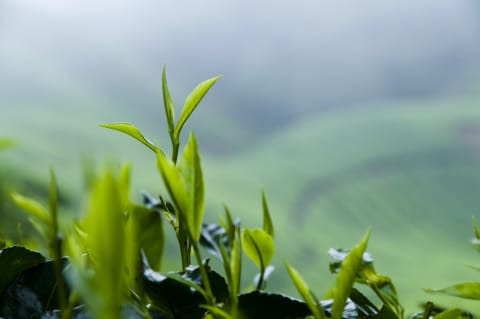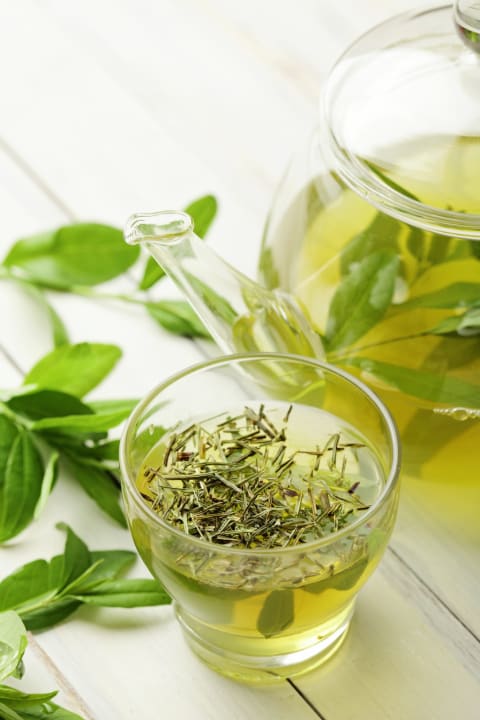Advertisement
Are You Drinking Toxic Tea? Here's How To Avoid Pesticides & Heavy Metals

Humans love tea. In fact, after water we drink more tea than any other beverage. How much do we love tea, you ask? Well, on any given day, over 159 million Americans drink tea. In 2016 alone, Americans drank over 84 billion servings (that’s over 3.8 billion gallons) of some type of tea. While about 86 percent of tea drinkers stick with the black variety (green is a distant second), you’ll find a ton of varieties on your grocery or health food store shelves.
"What determines whether a tea is green, black, white, or oolong depends entirely on the degree of processing that the leaves of the Camellia sinensis plant undergo after they’ve been harvested," says Jonny Bowden, Ph.D., in The 150 Healthiest Foods on Earth. "Here’s the short summary: Black tea is fully fermented; oolong tea is partially fermented; green tea is not fermented at all but pan-fried and dried; and white tea is barely processed." Herbal tea is made from other leaves, roots, and fruits and are not made from Camelia sinensis, which also means they are generally caffeine-free.
The health benefits of tea.
Bowden says tea contains over 4,000 health-promoting compounds, including epigallocatechin gallate (EGCG) and L-theanine. EGCG provides1 antioxidant, anti-inflammatory, anti-proliferative, anti-infective, and cardio-protective benefits. Tea is also the only plant that makes the amino acid L-theanine, which is known for2 calming and focusing the mind and reducing stress.
Traditional Chinese medicine and ayurvedic practitioners have long used tea to improve digestion, accelerate wound healing, stabilize blood sugar, improve heart health, and boost mental function. And modern research shows regularly drinking tea can benefit various conditions, including type 2 diabetes, obesity3, mood disorders, and even some cancers4.

Potential toxins in your tea.
Tea itself is really healthy, but it can sometimes be contaminated with pesticides and heavy metals. Tea plants are "hyperaccumulators," meaning they are extremely proficient at extracting agents from the soil and accumulating them in their leaves.
That means you want to be aware of where your tea is grown, how manufacturers process and package it, and even what kind of tea bags they use. China is the world’s largest tea producer, with 8 million tea growers. Unfortunately, they are also the world’s largest pesticide user. Manufacturers don’t usually wash tea leaves before they’re bagged or packaged, so if the plants are doused with pesticides, they will infuse directly into your cup.
On top of pesticides, teas can also contain artificial colorings, flavorings, and genetically modified ingredients (GMOs). In one investigation, researchers at Greenpeace China found all tea samples from China tested positive for at least three kinds of pesticides, with one-third containing up to 29 different pesticides (many of them illegal). Tea plants naturally accumulate fluoride and other heavy metals including lead, aluminum, and arsenic. Because tea grows in acidic soils, an even higher uptake of these metals can accumulate. Fluoride toxicity can result5 in a variety of health problems such as joint pain, muscle weakness, osteoporosis, brittle teeth, kidney problems, and even cancer. Among its problems, aluminum can be associated6 with Alzheimer’s disease.
Tea bags carry their own problems. Most paper tea bags are treated with epichlorohydrin, a known carcinogen. Silky tea bags are made from plastics like nylon or polypropylene that are unstable in hot water. Yes, bagged tea is more convenient, but consider loose-leaf teas instead.
How to choose the highest quality, safest tea.

All that is not to make you panic but to become more aware of what kind of tea you buy. One solution is to buy the highest-quality tea. Lower-quality teas have more heavy metals because they consist of fallen, older leaves, while newer top leaves and buds that have absorbed less are reserved for higher-grade tea products. Organic tea might be cleaner but not always, since they will be free of most pesticibes but still might be contaminated with heavy metals or other chemicals. Ditto with higher-grade teas, which might be less toxic, but the specific farm they are from, how their harvested, and the country of origin matters. Teas from China and India are generally more contaminated than those from Japan (due to industrialization).
I’ll go back to what I said before: The right teas are perfectly healthy, and you should drink as many varieties as possible. Equipped with a little knowledge, you can make the most-informed decisions about choosing the right ones. Use these seven strategies to make the most informed decision possible:
- Always buy certified organic and non-GMO tea.
- Restaurants and coffee shops often carry inexpensive, lower-quality teas. Consider bringing your own bag and simply ask for hot water. (Bonus: You might save a few bucks.)
- Drink your tea plain. If you need flavor, add a little bit of organic stevia and unsweetened coconut creamer.
- Read labels carefully and skip products with added flavors (even "natural" flavors); potential GMO ingredients including soy lecithin and cornstarch, corn syrup, and other additives.
- If you choose bagged tea (remember loose leaf is better), buy ethical brands that state their bags are epichlorohydrin-free.
- Use filtered water instead of tap water.
- Remember that steeping tea for more than three minutes can potentially increase heavy metal infusion, particularly lead and aluminum. As a general rule, can steep white tea for one to three minutes and green and black tea for three minutes.
Want to bring your green tea to a new level? Try making this cinnamon matcha.
6 Sources
Watch Next
Enjoy some of our favorite clips from classes
Enjoy some of our favorite clips from classes
What Is Meditation?
Mindfulness/Spirituality | Light Watkins
Box Breathing
Mindfulness/Spirituality | Gwen Dittmar
What Breathwork Can Address
Mindfulness/Spirituality | Gwen Dittmar
The 8 Limbs of Yoga - What is Asana?
Yoga | Caley Alyssa
Two Standing Postures to Open Up Tight Hips
Yoga | Caley Alyssa
How Plants Can Optimize Athletic Performance
Nutrition | Rich Roll
What to Eat Before a Workout
Nutrition | Rich Roll
How Ayurveda Helps Us Navigate Modern Life
Nutrition | Sahara Rose
Messages About Love & Relationships
Love & Relationships | Esther Perel
Love Languages
Love & Relationships | Esther Perel











